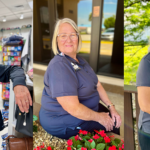Martin Memorial Health Systems serves a community that traditionally has been a retirement haven for seasonal residents.
That means there are any number of ailments related to aging that local residents endure, ranging from strokes to arthritis, joint replacements to peripheral neuropathy. At the same time, the region has grown significantly in recent years, bringing an influx of younger residents with differing needs. To accommodate this diverse population, Martin Memorial has created a comprehensive rehabilitation department that stretches throughout two counties and integrates physical, occupational and speech therapies.
Mike Vlasic, a physical therapist at Martin Memorial, attaches equipment for anodyne therapy onto the feet of a patient who has peripheral neuropathy.
- The Spine-Six BioMotion Spinal System. A specialized chair that is separated into four segments that can be adjusted by an attached computer, making precise movements that can help alleviate back, neck and leg pain caused by spinal ailments. The spine is mobilized in a gravity-free, relaxed position with gentle, controlled motions precisely measured by a computer. It allows back muscles to relax and the joints in the spine to remain in a normal range of motion.
- Anodyne therapy. Designed to treat peripheral neuropathy, anodyne is a monochromatic infrared energy device that uses single wavelength energy to relieve neuropathy pain and improve nerve function by increasing blood flow to the affected area. This therapy is also used with balance training, as well as stretching and strengthening exercises.
- Balance Master from NeuroCom. For patients with vestibular disorders or balance disorders, the equipment uses computer technology to measure their balance and posture using tests that mimic daily activities and real-world conditions. The tests are followed up with specialized exercises to regain balance.
Finding the right new technology to complement traditional therapy methods can be challenging at times. But at Martin Memorial, keeping an eye on the future has produced outstanding outcomes for rehabilitation patients.

























